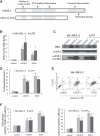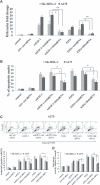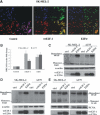E2F-1- and E2Ftr-mediated apoptosis: the role of DREAM and HRK
- PMID: 21564512
- PMCID: PMC3822935
- DOI: 10.1111/j.1582-4934.2011.01338.x
E2F-1- and E2Ftr-mediated apoptosis: the role of DREAM and HRK
Abstract
E2F-1-deleted mutant, 'truncated E2F' (E2Ftr, E2F-1[1-375]), lacking the carboxy-terminal transactivation domain, was shown to be more potent at inducing cancer cell apoptosis than wild-type E2F-1 (wtE2F-1; full-length E2F-1). Mechanisms by which wtE2F-1 and E2Ftr induce apoptosis, however, are not fully elucidated. Our study demonstrates molecular effects of pro-apoptotic BH3-only Bcl-2 family member Harakiri (Hrk) in wtE2F-1- and E2Ftr-induced melanoma cell apoptosis. We found that Hrk mRNA and Harakiri (HRK) protein expression was highly up-regulated in melanoma cells in response to wtE2F-1 and E2Ftr overexpression. HRK up-regulation did not require the E2F-1 transactivation domain. In addition, Hrk gene up-regulation and HRK protein expression did not require p53 in cancer cells. Hrk knockdown by Hrk siRNA was associated with significantly reduced wtE2F-1- and E2Ftr-induced apoptosis. We also found that an upstream factor, 'downstream regulatory element antagonist modulator' (DREAM), may be involved in HRK-mediated apoptosis in response to wtE2F-1 and E2Ftr overexpression. DREAM expression levels increased following wtE2F-1 and E2Ftr overexpression. Western blotting detected increased DREAM primarily in dimeric form. The homodimerization of DREAM resulting from wtE2F-1 and E2Ftr overexpression may contribute to the decreased binding activity of DREAM to the 3'-untranslated region of the Hrk gene as shown by electromobility shift assay. Results showed wtE2F-1- and E2Ftr-induced apoptosis is partially mediated by HRK. HRK function is regulated in response to DREAM. Our findings contribute to understanding the mechanisms that regulate wtE2F-1- and E2Ftr-induced apoptosis and provide insights into the further evaluation of how E2Ftr-induced apoptosis may be used for therapeutic gain.
© 2012 Foundation for Cellular and Molecular Medicine/Blackwell Publishing Ltd.
Figures







Similar articles
-
E2F-1 lacking the transcriptional activity domain induces autophagy.Cancer Biol Ther. 2012 Sep;13(11):1091-101. doi: 10.4161/cbt.21143. Epub 2012 Jul 24. Cancer Biol Ther. 2012. PMID: 22825328 Free PMC article.
-
Fas signaling and blockade of Bcr-Abl kinase induce apoptotic Hrk protein via DREAM inhibition in human leukemia cells.Haematologica. 2002 Sep;87(9):903-7. Haematologica. 2002. PMID: 12217801
-
Interleukin 3-dependent activation of DREAM is involved in transcriptional silencing of the apoptotic Hrk gene in hematopoietic progenitor cells.EMBO J. 2001 May 1;20(9):2286-92. doi: 10.1093/emboj/20.9.2286. EMBO J. 2001. PMID: 11331593 Free PMC article.
-
Cell cycle transcription control: DREAM/MuvB and RB-E2F complexes.Crit Rev Biochem Mol Biol. 2017 Dec;52(6):638-662. doi: 10.1080/10409238.2017.1360836. Epub 2017 Aug 11. Crit Rev Biochem Mol Biol. 2017. PMID: 28799433 Review.
-
[DREAM/Calsenilin/KChIP3: a new multifunctional protein in nervous system].Sheng Li Ke Xue Jin Zhan. 2005 Jul;36(3):199-203. Sheng Li Ke Xue Jin Zhan. 2005. PMID: 16270816 Review. Chinese.
Cited by
-
Novel combination of sorafenib and celecoxib provides synergistic anti-proliferative and pro-apoptotic effects in human liver cancer cells.PLoS One. 2013 Jun 12;8(6):e65569. doi: 10.1371/journal.pone.0065569. Print 2013. PLoS One. 2013. PMID: 23776502 Free PMC article.
-
E2F1 interacts with BCL-xL and regulates its subcellular localization dynamics to trigger cell death.EMBO Rep. 2018 Feb;19(2):234-243. doi: 10.15252/embr.201744046. Epub 2017 Dec 12. EMBO Rep. 2018. PMID: 29233828 Free PMC article.
-
Transcription addiction: can we garner the Yin and Yang functions of E2F1 for cancer therapy?Cell Death Dis. 2014 Aug 7;5(8):e1360. doi: 10.1038/cddis.2014.326. Cell Death Dis. 2014. PMID: 25101673 Free PMC article. Review.
-
E2f1 Overexpression Reduces Aging-Associated DNA Damage in Cultured Cerebral Endothelial Cells and Improves Cognitive Performance in Aged Mice.Oxid Med Cell Longev. 2025 Jul 28;2025:3242282. doi: 10.1155/omcl/3242282. eCollection 2025. Oxid Med Cell Longev. 2025. PMID: 40761766 Free PMC article.
-
Mining prognostic markers of Asian hepatocellular carcinoma patients based on the apoptosis-related genes.BMC Cancer. 2021 Feb 18;21(1):175. doi: 10.1186/s12885-021-07886-6. BMC Cancer. 2021. PMID: 33602168 Free PMC article.
References
-
- Phillips AC, Vousden KH. E2F-1 induced apoptosis. Apoptosis. 2001;6:173–82. - PubMed
MeSH terms
Substances
LinkOut - more resources
Full Text Sources
Research Materials
Miscellaneous

